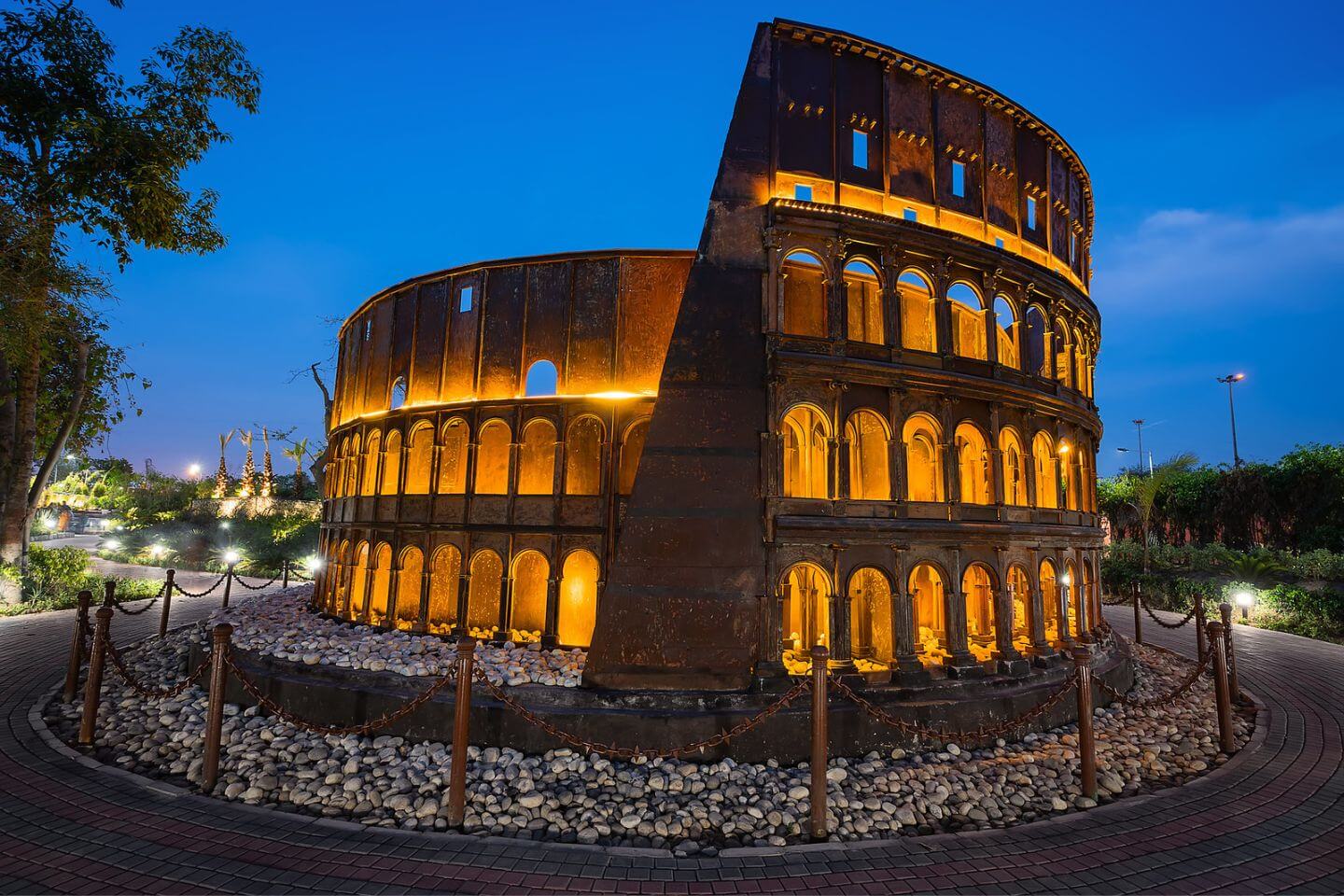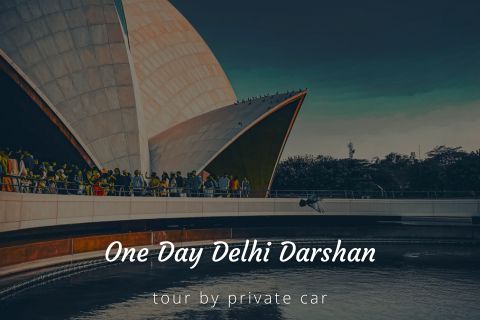
Waste to Wonder Park Entry Fee
- 50 Adult (13 to 64 yrs)
- 25 Child (4 to 12 yrs)
- 0 Children below 3 yrs and Sr. Citizen (Age 65+)
Waste to Wonder Park Phone
N/A
Rating:  | 4 stars, of total 103 reviews
| 4 stars, of total 103 reviews
Waste to Wonder Park Address: Near Hazrat Nizamuddin Metro Station, Block A, Ganga Vihar, Sarai Kale Khan, New Delhi, Delhi, 110013, India
Delhi City Tour Packages
Waste to Wonder Park Timings
| Day | Timing |
|---|---|
| Monday | Closed / Holiday |
| Tuesday | 11:00 am – 11:00 pm |
| Wednesday | 11:00 am – 11:00 pm |
| Thursday | 11:00 am – 11:00 pm |
| Friday | 11:00 am – 11:00 pm |
| Saturday | 11:00 am – 11:00 pm |
| Sunday | 11:00 am – 11:00 pm |
The capital city of India is known for its verdant greens, among many other attractions. While most parks stop at being a visual delight, New Delhi’s Waste to Wonder Park serves another purpose – effective utilization of waste materials. All of the models inside the park are made of scrap items.
Alternatively known as the Seven Wonders Park and Waste of Wonder Park, this theme park has life-size models of seven iconic monuments around the world, namely the Taj Mahal, the Leaning Tower of Pisa, the Pyramids of Giza, the Colosseum of Rome, the statue of Christ the Redeemer, the Statue of Liberty and the Eiffel Tower.
Waste to Wonder Park (New Delhi) Timings & Ticket Price
Delhi’s Waste of Wonder Park is open on all days of the week from 11 AM until 11 PM, except Mondays and national holidays when it is closed. The entry fee levied is on the basis of one’s age. However, all students of municipality schools can enter without any charge, irrespective of their age.
Toddlers who are 3 years and under, and senior citizens who are 65 years old and above, enter for free. For children between the ages of 4 and 12 years, the fee is INR 25 per child. 13 to 64-year olds are charged INR 50 per head. If you plan to park your vehicle, there is an extra charge that is levied.
History Behind the Waste to Wonder Park (New Delhi)
The Seven Wonders of World Park in Delhi was commissioned by the South Delhi Municipal Corporation (SDMC) as part of their Waste-To-Art Project which aims to effectively manage the city’s waste and also contribute to the beautification of public spaces. The entire project took just 6 months to complete!
The Waste to Wonder Park was inaugurated on 21st February 2019 by the then Home Minister of India, Rajnath Singh. It was opened to the general public the very next day. The aim behind the development of this park was to provide a fillip to the Prime Minister’s ‘Swachh Bharat Abhiyan’ (or Clean-Up India Campaign) while also generating income from tourism as waste literally turns into wealth.
Image Gallery of Waste to Wonder Park
Layout of the Waste to Wonder Park (New Delhi)
Spread across 5 acres of land, the Waste of Wonder Park New Delhi is arrayed into 7 distinct sections, each focusing on a wonder of the world. Each of these monuments is shielded by a dense cover of trees so that the onlooker can admire a single attraction at a time, without getting distracted by the other models nearby.
1. The Taj Mahal: India’s most famous marble edifice, the Taj Mahal of Agra has been replicated in this park to a height of 20 feet. 30 tonnes of waste materials have gone into the making of the miniature Taj Mahal. A total of 24 labourers worked on this piece for 5 and a half months. There is also a set of fountains inside the rectangular pond that is built right in front of this monument.
Techniques and scrap items used in the construction are benches for door and window frames, 2-inch pipes for domes, truck sheets and laser cut technology to imitate the intricate work on the body of the building, and several other materials such as old pans, 1,600 cycle chains to make the pillars, park benches, electric pole pipes, angles, swings and truck springs.
2. The Great Pyramid of Giza: The Waste of Wonder Park has an 18-feet tall pyramid made of 110 layers. Conceptualized by the architect Pijush Patra from Vadodara, Gujarat, this replica of Egypt’s ancient pyramid has been made exclusively with scrap angles measuring 10,800 feet and weighing almost 12 tonnes in total.
3. The Colosseum of Rome: The 16-feet 6-inch high Colosseum in Delhi is a tribute to the ruined Roman wonder in Italy. Created using 11 tonnes of scrap materials, the waste includes items such as 410 car wheels for the arches, electric poles, automobile spare parts, benches and metal railings.
4. Christ The Redeemer of Rio: Standing 25 feet tall, Rio de Janeiro's Christ the Redeemer has been miniaturized to suit the aesthetics of the Waste to Wonder Park. The statue of Jesus Christ took about 5 months to be completed by the artist Shubham from the city of Vadodara. The creative flair can be seen in elements such as the making of hair using motorbike chains, the creation of a pedestal using square pipes from old benches, engine parts to make the palm of the hands, and electric poles to make art of the clothing.
5. The Statue of Liberty: Measuring 35 feet in height, the mini Statue of Liberty carries about 8 tonnes of waste. Designed by a Delhi-resident, Zakir, the statue is a sight to behold. The tablet in Lady Liberty’s hand is made of metal sheets from tea stalls and a bench belonging to the Municipal Corporation of Delhi The pedestal is made of angles, metal railings and scrap pipes to lend it the appearance of bricks. Car rims have been used to create the rings on the pedestal. The torch held by Lady Liberty is made of the parts of an old bike. Cycle chains form her hair.
6. The Eiffel Tower: At 60 feet, the miniature Eiffel Tower is the tallest wonder in Delhi’s Seven Wonders of World Park. 40 tonnes of automobile scrap have gone into the making of this Parisian icon. The three levels of this Eiffel Tower were constructed individually before they could be affixed atop each other with the use of an industrial crane. The artist behind this work of art is Sandip Pisalkar. The waste matter used to build this structure includes angles, trucks’ diesel tanks, C-channels and clutch plates.
7. The Leaning Tower of Pisa: Even Delhi’s version of the Leaning Tower of Pisa leans gracefully, measuring 25 feet in height. The 80-degree tilt makes for great photo ops. Cycle rims have contributed to the 211 total arches that grace the 8 storeys of this tower. Old pipes have been used to make the pillars, while scrap metal sheets have turned into diamond formations under the arches. A total of 10.5 tonnes of waste has gone into the making of this Leaning Tower of Pisa.
Things to do at the Waste to Wonder Park (New Delhi)
India’s capital city has provided every visitor with a wonderful way of celebrating the spirit of cleanliness, recycling and waste conservation through the medium of the Waste of Wonder Park. Here are some fun activities you can do while exploring this park:
1. Carry your best phone cameras, DSLRs, lenses and even a tripod while you visit the Waste to Wonder Park New Delhi. While amateur photographers can rejoice in the selfies that can be clicked against these famous monuments, professionals can take solace in getting gorgeous angles with their premium gear.
2. A great place for an evening walk or a leisurely stroll, the park looks stunning when all the seven wonders are lit up, creating a romantic mood for dating couples.
Interesting Facts About the Waste to Wonder Park (New Delhi)
While the theme of the Waste to Wonder Park is interesting in itself, there are many intricate factors that make it more endearing to visitors:
1. Even the toilet at the Waste of Wonder Park is made of an old shipping container with solar panels on its roof. The exterior is painted in bright colours to highlight the theme of the seven wonders of the world.
2. As you enter the Waste of Wonder Park Delhi, you will notice that even the entry gate is made of old grass cutter and a portion of a dilapidated bench. Typewriter parts and spring form the entrance arch. This design was conceived by Ram Kumar, an artist from Tamil Nadu.
3. The self-sustaining, carbon-neutral and totally “green” park is powered by 3 windmills (which generate 1 kilowatt of electricity each), 18 sun-tracking solar panels (with a total of 10 kilowatt energy-generation capacity) and even 3 solar trees (each of which create 5 kilowatt of energy). The energy generated from these renewable sources is used to light up the entire park after dark, when it looks even more enchanting to the tourists.
4. The Seven Wonders Park is energy positive as it generates a total of 28 kilowatts of energy while consuming only 15 to 25 kilowatts. The excess energy is exported to the city’s power grid, garnering extra revenue for the SDMC.
5. Most of the scrap materials were procured from the landfills of New Delhi.
6. Interestingly, the idea came to the South Delhi Municipal Commissioner, Dr. Punnet Goel, after he watched the Bollywood movie ‘Badrinath ki Dulhaniya’ which was shot in Kota’s Seven Wonders Park.
7. The Waste to Wonder Park was a collective effort of 5 main artists, 7 supporting artists, 50 labourers and 70 welders from various parts of India.
8. A total of 150 tonnes of waste was used in the creation of these 7 wonders which have cost 7.5 crore rupees in all.
9. Although the structures are made of scrap which seem as though they will rust soon, this won’t happen as anti-rust enamel is painted on all the surfaces.
10. The Waste to Wonder Park has plenty of green spaces surrounding each monument and most of the area is open to people who wish to enjoy their picnics. Since there are no cafes inside the park, one has to buy food and water if the plan is to stay for longer hours. The park does not allow people to bring their own food, but they can buy from the vendors nearby.
11. There is a possibility that this park will be given out on a rental basis for movie shootings, pre-wedding photo shoots and similar activities.
12. Even materials from 24 municipal stores have gone into the making of the icons at the Seven Wonders Park of Delhi. These archaic appliances include defunct sewer lines, fans, motorbike parts, rods, bicycle parts, bolts, nuts, iron sheets and other on-functional appliances.
13. 66 four-wheelers and 31 two-wheelers can be accommodated at the parking space of the Waste to Wonder Park. If you don’t wish to take your vehicle along, you can also halt at this park on the Hop On Hop Off bus which takes you on a tour of several other important sites in New Delhi.
Places to Visit Near Waste to Wonder Park (New Delhi)
New Delhi is one of the most interesting places to be in. If you are travelling for the first time, you will be amazed by the plethora of historical attractions that the city is home to. Forts and tombs apart, Delhi also has a number of sprawling gardens and shopping centres. After you finish exploring the Waste to Wonder Park, you can head to these locations nearby:
1. Millennium Park: About 6 km from the Seven Wonders Park, Millennium Park can be easily reached within 10 minutes of driving along the National Highway 44. Spread over 20 acres, this park is noteworthy for its creative use of a former wasteland. Open on all days of the week from 11 AM until 11 PM, Millennium Park has ample parking space. Once can relax in the landscaped greens, jog or let the children enjoy in the Kids’ Park. The park also has a food court and public toilets which are free of charge.
2. Humayun’s Tomb: At a distance of 4 km from the Waste of Wonder Park, Humayun’s Tomb takes around 10 minutes to arrive at. A splendid example of Mughal Architecture, Humayun’s Tomb is a UNESCO World Heritage Site. Made of red sandstone, the tomb was built in the 16th century A.D. for the Mughal Emperor Humayun. The monument and the surrounding garden is open to visitors on all days of the week from 8 AM to 6 PM.
3. National Zoological Park: Around 6 km from the Waste to Wonder Park, this zoo is reachable within 20 minutes. Home to more than a thousand animals, the National Zoological Park covers a total area of 176 acres. The park is open from 9 AM to 4:30 AM on all days of the week except Fridays. Keep your eyes peeled for royal Bengal tigers, Asiatic lions, deer, chimpanzees, hippopotamuses, monkeys and more.
How to Reach the Waste to Wonder Park (New Delhi)
Located in South Delhi’s Rajiv Gandhi Smriti Van, it is quite easy to find the Waste to Wonder Park in the capital of India. You can choose from various modes of transport to make your way into this ecological park, also known as ‘The Waste of Wonder Park’:
By Air: The Indira Gandhi International Airport is the nearest airport that you can catch a flight to. You will be able to get on a bus to Sarai Kale Khan bus stop which is just a few hundred metres from the Waste of Wonder Park. The airport itself is about 20 km from the park, taking almost half an hour by road. You will be able to book your cab and also conveniently locate it at the airport’s designated cab bays for radio taxis and regular cabs.
By Train: If you are visiting Delhi by train, you will do well to book a route that halts at the city’s Hazrat Nizamuddin Railway Station as this is just 700 metres from the Waste to Wonder Park. You can walk for 10 minutes to get to the park or take a cab or an auto-rickshaw for the 2-minute road journey. You will find no dearth of trains to the capital, irrespective of the part of India you are travelling from.
By Metro: Delhi’s highly successful and preferred mode of transport for the working population is the Metro. The city has several lines that connect various parts of Delhi. The closest metro station to the Waste of Wonder Park is the Sarai Kale Khan – Nizamuddin or the Hazrat Nizamuddin Metro Station which is only a few hundred metres away and walkable. The metro coaches are air-conditioned and very safe and quick as compared to many other modes of transport.
By Bus: In Delhi, not every area is covered by the state run bus route. However, this part of South Delhi enjoys having the Sarai Kale Khan bus stop which is about 900 metres from the Waste to Wonder Park. You can walk for 12 minutes to get to the actual park or hail an auto-rickshaw to take you there. Beware of overcrowded buses where pickpocketing is a risk, apart from feeling claustrophobic.
By Car: One of the most comfortable ways to travel in and around Delhi is in an air-conditioned cab. Given how the city can make one faint in the summers or shiver in the frigid winters, a car equipped with air conditioning and heating is ideal. Book a car from top car rental companies in Delhi with a professional driver who knows the routes of the city well, so you can remain stress-free throughout your trip to the Waste to Wonder Park.
Delhi Tourism, a division of Holidays DNA helps you in planning your holiday with its all inclusive Delhi Tour packages that include a tour of popular places to visit in Delhi. Please fill the Contact Us form to reach us.



